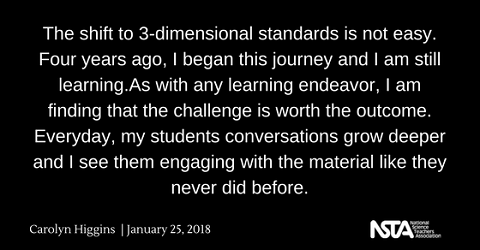Finding 3-Dimensional Inspiration
By Korei Martin
Posted on 2018-01-25

With adoption and subsequent implementation of the Next Generation Science Standards in my state (Rhode Island was first to adopt- gulp!), I have taken the last few years to shift to three dimensional lessons that focus on conceptual learning. As I have gathered nuggets of information to help me with the transition in my own classroom, I have noticed that there is an increase resources available (some great, others meh) and new opportunities for professional learning, both online and face-to-face. While I appreciate my well-intentioned curriculum supervisor’s purchase of a kit that claims to be NGSS-aligned, I supplement their ‘canned’ lessons with more engaging ideas. I find lesson ideas and opportunities for professional learning in a variety of places, my top 3 favorites are here.
NGSS@NSTA Hub Recorded webinars, curated activities, and printable resources– Oh My! NSTA has trained 50+ educators on recognizing and critiquing lesson resources that potentially align to 3-dimensional standards. These trained curators have been working for a few years and have accumulated many reviews of resources that are free or reasonably priced that anyone can access at the Hub. The reviews are conveniently listed on the page with the performance expectation that they align to under the ‘Standards’ tab. It is important to carefully read the review that the curator has provided in order to be sure to use the resource in a manner that explicitly includes the three dimensions. The Hub also has pdf resources that educators can share with parents or use in professional learning to educate others about the shifts in science education. I have used these in my email updates to parents or to justify professional development time to administrators. NSTA regularly hosts webinars on specific topics related to implementing 3-dimensional standards. Some have a small cost and others are free. NSTA enlists the help of NGSS-gurus to deliver presentations that can be watched with colleagues or at home in your pajamas.
Twitter If you are not using Twitter, you are missing out! I have grown a sizeable Professional Learning Community (PLC) through twitter chats like #ngsschat (the 1st & 3rd Thursday evening of each month) and #NSTAchat (the 2nd Thursday of each month). I can discuss lesson ideas with colleagues (who may be located anywhere) as well as find or share lesson resources, assessment strategies, potential field trips, and intriguing videos. It is like having an infinite science department at my fingertips. When I find myself with a few minutes (waiting rooms, at the dmv) to kill, I scroll through items and read articles or bookmark sites that look useful. Don’t wait any longer, get the app or log on on your device today! Feel free to follow me @mrshigginsri and check out who I am following. You will find rockstar educators, NGSS writers, and newbie teachers supporting science education for all students through collaboration. You can participate in chats or just read through the posts to harvest ideas and resources. The sharing is endless!
Stemteachingtools.org This is an ever-growing treasure-trove of “tools” that address issues that arise while teaching science. Phil Bell and a host of other science education researchers have developed the tools to “leverage the best knowledge from research and practice” on that specific topic. I have used tools to improve engagement during class discussion, be more explicit with questioning strategies that focus on a specific cross cutting concept, as well as find new ways to formatively assess students. Many tools would be excellent discussion starters for face-to-face professional learning in a science department. PD Modules on the site include presentation materials that would be ideal for in-service days or district workshops. Everytime I visit the site there are new items added and the developers invite educators to submit potential topics for future tools.
While these are my favorite places to find inspiration for teaching in an age of 3-D lessons, there are many other site I visit and find nuggets. Phet simulations, PBS Learning Media, and HHMI Biointeractive all have engaging media that can incorporated into lessons and activities. If you are looking for engaging phenomena to turn on the wonder in your students, sciencephenomena.com and ngssphenomena.com are packed with ideas. Lastly, I would be remiss if I did not mention the epicenter of 3-dimensional instruction. Nextgenscience.org has sample lessons and assessments that are being supplemented by peer-reviewed materials. Everytime I visit, I find new resources have been included.
The shift to 3-dimensional standards is not easy. Four years ago, I began this journey and I am still learning. As with any learning endeavor, I am finding that the challenge is worth the outcome. Everyday, my students conversations grow deeper and I see them engaging with the material like they never did before. Their arguments are supported by evidence and they develop questions about a range of topics. Even though there have been moments that I have felt like a new teacher, I see the benefit of this shift and find that the change is worth the effort.
 Get more involved with NSTA!
Get more involved with NSTA!
Join NSTA today and receive Science Scope, the peer-reviewed journal just for middle school teachers; connect on the middle level science teaching list (members can sign up on the list server); or consider joining your peers for Meet Me in the Middle Day (MMITM) at the National Conference on Science Education in Atlanta in the spring of 2018.
The mission of NSTA is to promote excellence and innovation in science teaching and learning for all.
Future NSTA Conferences
2018 National Conference
NGSS Workshops
2018 STEM Forum & Expo, hosted by NSTA
2018 Area Conferences
Follow NSTA
Disclaimer: The views expressed in this blog post are those of the author(s) and do not necessarily reflect the official position of the National Science Teaching Association (NSTA).


